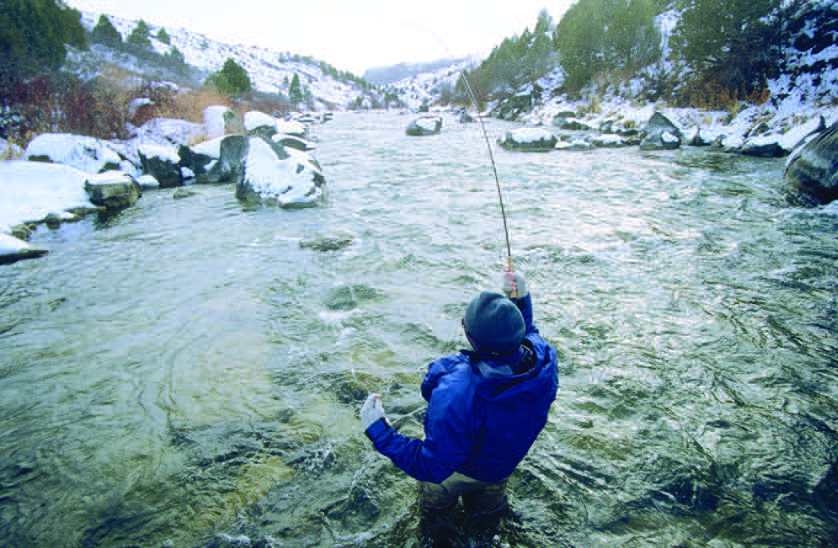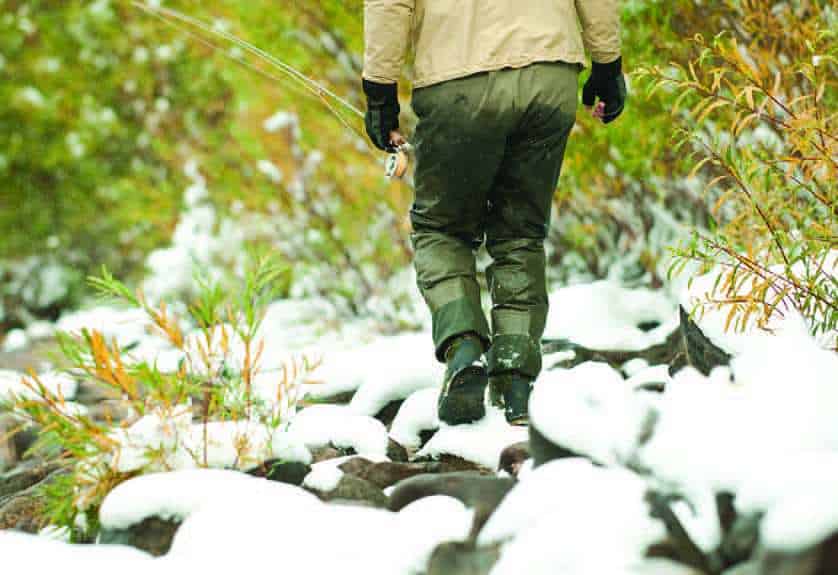Read The
Current Issue

Cold-Weather Casting
Fanatics fish on in winter.
BY KELSEY DAYTON
PHOTOGRAPHY BY JEFF DEINER
IT’S COLD. REALLY cold. And the fish don’t always bite. When they do, it’s an almost imperceptible tug. The drama of the big fight and the constantly whipping line are gone. They’re replaced by the sound of water rolling over rocks, the quiet whiz of the fishing line through the air, and the occasional crunch of boots or snowshoes on the frozen banks.
“The best thing about fly fishing in this region in the winter is the absolute solitude,” says Scott Smith, owner of Grand Teton Fly Fishing. “It’s very quiet. But you gotta really want it.”
Winter fishing in Jackson Hole is not for those who fear the cold. It’s for the fanatics who can’t bear to go too long without a cast and also, come a certain time in winter, those in the know. Those who know know that some of the region’s best fishing of the year happens when it still feels like winter, but the river knows it’s spring.
THERE ARE ONLY a few ardent anglers who brave the valley’s ice-rimmed waters in the middle of Wyoming’s winter. Those who do usually call Jason Balogh, whose Fish the Fly guide service is one of the few—and maybe the only (but that might soon be changing)—companies to offer guided winter fishing trips. It is rare in the heart of winter—December, January, and February—to have clients, Balogh says, but occasionally a warm spell, where temperatures rise to 20 or 30 degrees, hits and someone calls him for a trip.
“Then it snows, and they cancel to go to the mountain,” Balogh says. But every once in a while, someone is up for braving the elements.
“Winter fishing is certainly a different experience, and it’s for a hardy soul,” Balogh says. “We fisherpeople are pretty fanatical about it—even when it’s cold.”
This heart-of-winter fishing can happen on nearby rivers like the Henry’s Fork, Madison, and Green, but, when the water is its coldest and darkest, fish like to congregate in the deepest holes. “And that’s on the Snake,” Balogh says. “In winter, the river fishes best from Wilson down through the canyon.” A plus for people? This stretch is generally warmer—the air temps, not water temps (those tend to be about the same)—than the stretches of river in the more northern areas of the valley.
Between November and February, the Snake’s boat launches are snowed in. Also, the river is frozen in parts. So Balogh’s trips are always walk-wade; you’ll snowshoe or cross-country ski your way to the river’s banks, scramble down as close as you can get, settle in, and cast from within the frigid waters, dressed as though you were skiing on the coldest of days and then some.

Not surprisingly, winter fish are more lethargic. So the most productive type of winter fly fishing is nymphing, which means the fly goes below the surface, Balogh says. If fish won’t rise to take bait, fishermen need to send the bait down to them. Weighted flies need to make their way to depths of ten or more feet.
“You basically have to hit the fish in the face,” Balogh says. The strikes are subtle and the takes anticlimactic; suddenly the indicator just stops. But in the winter, that’s enough. “If you get a little tug in the middle of the winter, it can do a brother good,” he says.
Winter trips are in the middle—the warmest—part of the day and are often only a few hours. Because really, that’s about as long as you can stand in moving water that, even in the middle of August, is barely above 50 degrees. (Winter temps are in the low 30s.) You might catch a few trout or whitefish, or you might not. It doesn’t matter. “Fishing is a spiritual thing, and you can never get enough of that,” Balogh says.
“There are few options for guided winter fishing trips in the valley, and it’s a novel experience,” says Smith of Grand Teton Fly Fishing. “It’s a really unique experience for the ardent angler.”
Like Balogh, Smith’s trips combine snowshoeing and fishing. “Snowshoes or cross-country ski gear can allow an angler access to areas of the river that, in summer, are accessible by floating,” Smith says. “But in winter we can’t float them because of the deep snow. We can wade them because winter water levels are quite low. In winter, there are many more wading options than there are in the spring, summer, and early fall.”
“COME MARCH, PEOPLE really start calling,” Smith says. Sometime in March is that “certain time” mentioned at the beginning. The weather begins to turn. It is still winter, but there are hints of spring. “Fishing can be phenomenal,” Smith says.
The days are longer. Temperatures rise into the 30s, and the river begins to wake up. Fish move from their winter holes, and bugs—midges first, followed by blue-winged olives or mayflies—begin to arrive. The water is still low and clear, and the fish feed like mad. It starts slow, but by mid-March, fishing is usually going well.
“The last week of March is often some of the best fishing of the year,” Balogh says. By early April, midges, a cold-water bug, are in the Snake River by the “gazillions.” It’s still pretty chilly, but, “You can catch really big trout if you know what you’re doing,” Smith says.

Nuts & Bolts
If you want to fish on your own, the major rivers in the region good for winter fishing include the Snake, the South Fork, and the Henry’s Fork. Each fishery has specific regulations, requirements, licenses, and limits, though. Please check with Wyoming (or Idaho) Game & Fish. In this valley, the Snake is open mostly only for catch-and-release fishing year-round. If you want to keep your winter catch, you can target lake trout, an introduced species of char, on the Snake just below Jackson Lake Dam in Grand Teton National Park.
Grand Teton Fly Fishing: grandtetonflyfishing.com, 307/690-0910, half-day walk-and-wade trips throughout winter and into early spring start at $325
Fish the Fly: fishthefly.com, 307/690-1139, rates start at $295 for half-day trips between December and March




